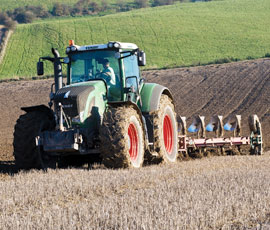New tool may help keep blackgrass under control

A new tool will help growers decide which strategies will offer cost-effective blackgrass control, as Louise Impey discovers.
Amanagement tool being developed by Bayer CropScience and Savills Agribusiness could help users identify how changes made to farming practices can impact on blackgrass populations and their control, claim the companies involved.
The intended use of the Black-grass Calculator is as a “what if?” facility, allowing agronomists and growers to see both the financial consequences and the agronomic outcomes of different management options, across the entire farm rotation.
“Most farmers know there are things they can do to improve their long-term blackgrass situation,” explains Chris Cooksley of Bayer CropScience. “But it is more difficult for them to work out the financial implications of any action across the same timescale.”
Furthermore, gaining an understanding of the effect of changes on the seed bank and resistance status of the weed is also difficult to achieve, he believes.
“But these factors are becoming increasingly important in the battle against blackgrass, especially as there are no new herbicide solutions on their way.
“It hasn’t been designed to make recommendations or specify chemical programmes. But it can show the effect of different practices on blackgrass populations and the financial impact of these decisions.”
Typical changes in a bad blackgrass situation might be to introduce spring cropping or to delay wheat drilling, continues Mr Cooksley. “But there are always concerns about lower yields and weather risks, as well as crop value.”
With the calculator, the farmer’s current rotation, field history and practice is inputted and used to establish a baseline, so that changes to either the rotation or agronomy can be investigated in detail.
“That could be alterations to cultivations, different cropping or a later drilling date. Once done, growers can see how they will affect the current situation, but also what will happen in the future.”
Currently undergoing testing, the calculator will be on wider release in the run-up to harvest 2013.
Testing the calculator
Oxfordshire farm manager and Farmer Focus contributor Simon Beddows (pictured below) has already made significant changes to his farming system, in an effort to get on top of blackgrass.
These include the introduction of spring cropping, with both spring beans and maize now having a place in the five-year rotation, as well as the use of a double break for the first time in 2012.
He also makes sure that he rotates the use of pre- and post-emergence chemistry across the 1,000ha farming business. “I take the view that all the blackgrass on this farm is resistant, and start from there.”
Multiple doses of low rate glyphosate are applied prior to drilling, where time allows, so that grassweed numbers are reduced as much as possible.

“We’re still getting control from Atlantis (iodosulfuron + mesosulfuron),” he reports. “But we only use it in first wheats and never apply it two years in a row. And applications are made in the autumn, with a residual partner, when the blackgrass is small.”
He switches to Broadway Star (florasulam + pyroxsulam) on less challenging fields and has seen a minor effect on blackgrass numbers by increasing seed rates.
“Spring crops have been very important,” says Mr Beddows. “Over a five-to-six-year timeframe, they’ve had a huge impact on blackgrass numbers. And their financial contribution is much better than it was after the first year.”
He still has two other techniques at his disposal – going back to ploughing and delaying drilling – neither of which has much appeal. “We aim to get everything drilled by 1 October. We’re on gravelly soils, so the crops are better if they’re in the ground in plenty of time.”
Ploughing hasn’t taken place for a number of years, he adds. “It would give us a problem with creating a good seed-bed. And I’m concerned that we could end up dragging some of the buried blackgrass seed up again later in the rotation if we went back to it.”
The chance to investigate whether either of these techniques would help with his blackgrass control was too good to turn down.
A test drive of the Bayer/Savills blackgrass calculator confirmed that he is on the right track. “It seems as though I’ve done what needs to be done for now. But I still get caught out by the weather from time to time – we have seen blackgrass in early drilled spring crops, for example, with no chemical means of controlling it.”
The calculator showed that shifting his drilling date back by two weeks wasn’t worth doing. “It doesn’t help to reduce the seed bank and the other effects are minimal. So I’ll stick to my original plan.”
Ploughing wouldn’t make life easier either, according to the calculator, or have the desired effect on the seed bank. “I wonder if a fallow year would be more beneficial on this farm.”
He would like the calculator to allow him to include dormancy information, although he recognises that moisture is a more important factor in determining blackgrass germination. In its present form, it doesn’t allow him to have maize in the rotation, although that’s something that Bayer intends to include.

